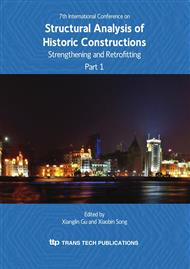p.807
p.815
p.821
p.831
p.837
p.843
p.849
p.855
p.861
Efficiency of CFRP Strengthening of Arches Tested by Failure of Historical Building after the Inappropriate Repair Intervention
Abstract:
This paper should be treated as continuation of considerations placed in the paper (Ciesielski et. al. 2004), where a strengthening of cracked masonry arches, based on CFRP laminates anchored in the brick walls, was presented. The efficiency of CFRP strengthening was tested by a sudden failure of the building caused by inappropriate repair intervention in fundaments and supported soil. Work of the arches strengthening survived the structure from catastrophic consequences. In the paper the failure process is reported and measurements of settlement and cracks width changes are presented. The rescue intervention in the cracked building is also described.
Info:
Periodical:
Pages:
837-842
Citation:
Online since:
October 2010
Authors:
Price:
Сopyright:
© 2010 Trans Tech Publications Ltd. All Rights Reserved
Share:
Citation:



